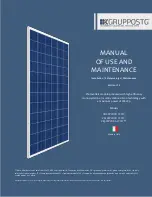
2. Mounting With Clamping Hardware
|
If module clamps are used to secure the module, the torque on the clamp bolt
should be around 8–10 Nm.
|
A minimum of four module clamps should be used, two on each long frame side,
in the general clamping areas denoted by the wide arrows on the drawing.
|
Depending on the local wind and snow loads, additional module clamps may be
required.
All dimensions in mm
3. Other
|
Other mounting methods are acceptable as long as the minimum requirement
as described under 2. Mounting with clamping hardware are met.
Electrical Installation
Grounding
|
All module frames must be properly grounded.
|
Observe all local electric codes and regulations.
|
A bonding or toothed washer is required to make proper and reliable electrical
grounding connection with the anodized aluminum frame.
|
Devices listed and identified for grounding metallic frames of PV modules are
permitted to ground the exposed metallic frames of the module to grounded
mounting structures. Per NEC 250.136, electrical equipment secured to and in
electrical contact with a metal rack or structure provided for its support and
grounded by one of the means indicated in 250.134 shall be considered
effectively grounded.
|
Consider using a lay-in lug, rated for outdoor use (Illsco
GBL4 DBT or equivalent), if the module grounding conductor
is to be larger than #10 AWG.
|
When using lay-in lugs, the grounding conductor should
be inserted into the opening indicated in the figure, and
secured using the set screw.
General electrical installation
|
Do not use modules of different configurations in the same system.
|
This module is supplied with Multi Contact connectors for electrical connections.
|
Refer to Section 690.31 of the NEC to determine appropriate types and
temperature ratings of conductors. Wiring should be #12 AWG, 4 mm²
(minimum) and must be temperature rated at 90 °C (minimum).
|
Completely cover system modules with an opaque material to prevent
electricity from being generated while disconnecting conductors.
|
Refer to Sections 690.8 and 310 of the NEC to determine overcurrent,
conductor ampacity and size requirements.
|
In Canada, installation shall be in accordance with CSA C22.1, Safety
Standard for Electrical Installations, Canadian Electrical Code, Part 1.
|
For best performance, ensure that positive and negative DC wires run
closely together avoiding loops.
WARNING!
Electrical shock hazard! Do not touch bare conductors
or other potentially energized parts.
Maintenance
Conergy recommends the following maintenance items to ensure optimum
performance of the module:
|
Clean the glass surface of the module as necessary. Use water and a soft
sponge or cloth for cleaning. A mild, non-abrasive cleaning agent can be
used if necessary. Do not use dishwasher detergent.
|
Electrical and mechanical connections should be checked periodically by
qualified personnel to verify that they are clean, secure and undamaged.
|
Check the electrical and mechanical connections periodically to verify that
they are clean, secure and undamaged.
|
Problems should only be investigated by qualified personnel.
|
Observe the maintenance instructions for all other components used in the
system.
Shutting down the system
|
Completely cover system modules with an opaque material to prevent
electricity from being generated while disconnecting conductors.
|
Disconnect system from all power sources in accordance with instructions
for all other components used in the system.
|
The system should now be out of operation and can be dismantled. In doing
so, observe the all safety instructions as applicable to installation.
Electrical ratings of the concerned modules:
S 180MU
175MU
Q 85MU
Maximum Power (P
MPP
)
180 W
175 W
85 W
Output Tolerance
–2/+ 3 %
–2/+ 3 %
+/- 5 %
Rated Voltage (V
MPP
)
35.6 V
35.2 V
17.6 V
Rated Current (I
MPP
)
5.05 A
4.95 A
4.83 A
Open Circuit Voltage (V
OC
)
44.4 V
44.2 V
21.9 V
Short Circuit Current (I
SC
)
5.4 A
5.2 A
5.14 A
Maximum System Voltage
600 V
600 V
600 V
Maximum Series Fuse Rating
15 A
15 A
15 A
Fire Class
C
C
C
The electrical characteristics are within ±10 % of the indicated values of I
SC
, V
OC
, and P
max
under Standard Test
Conditions (irradiance of 1000 W/m
2
, AM 1.5 spectrum, and a cell temperature of 25°C/77°F)
Disclaimer of liability
Because the use of this manual and the conditions or methods of installation,
operation, use and maintenance of photovoltaic products are beyond Conergy's
control, Conergy does not accept responsibility and expressly disclaims liability
for loss, damage, or expense arising out of or in any way connected with such
installation, operation, use or maintenance. No responsibility is assumed by
Conergy for any infringement of patents or other rights of third parties, which may
result from use of the PV product. No license is granted by implication or otherwise
under any patent or patent rights.
The information in this manual is based on Conergy's knowledge and experience
and is believed to be reliable, but such information including product specification
(without limitations) and suggestions does not constitute a warranty, expressed
or implied. Conergy reserves the right to change the manual, the product, the
specifications, or product information sheets without prior notice.
Information about manufacturer:
Conergy Inc.
1730 Camino Carlos Rey, Suite 103
Santa Fe, NM 87507
USA
www.conergy.us
Please consult your dealer or the manufacturer concerning the warranty of your
modules. If you have any further questions, your dealer will gladly assist you.
Subject to technical modifications without notice. 2007 © Conergy, Inc.
MODUL_Installation-UL-IM-ENG-0705
www.conergy.com | 2007 © Conergy AG
Installation | Safety instructions | Maintenance
Photovoltaic modules user manual
Conergy S 175/180MU/Conergy Q 85MU
each
900 mm
cable
150
485
485
150
485
150
485
150
Page 2/2




















